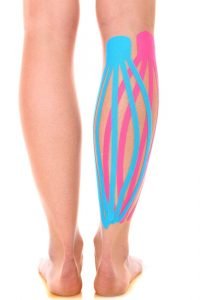
K Tape – What’s all the Hype About?
K Tape – What’s all the Hype About?

Kinesio tape or K-tape is a variety of tape that physiotherapists occasionally apply to the skin with the intention of providing a therapeutic benefit. K-tape is derived from the word kinesiology, which is the study of human movement. Unlike rigid strapping tape, used by physiotherapists to restrict joint movement, K-tape is a thin, elastic cotton tape designed to stretch and allow movement. My Physio Perth uses the highest quality Leuko rigid strapping tape and Rock tape’s version of K-tape.
What does K-Tape do and how does it work?
Various kinesio tape manufacturers claim different therapeutic benefits. My Physio Perth uses Rock tape, which claims to decompress the tissue just under the skin, creating four different effects:
- Improved fluid movement below the skin, allowing swelling to flow out of the area and blood to flow into the area.
- Reduced pressure on the tissues between the skin and bone allowing easier gliding of these tissues during movement.
- Reduced pressure on the nerve endings just below the skin leading to a reduction in pain.
- Stimulation of receptors in the skin leading to improved proprioception or movement awareness.
In summary, K-tape is commonly used to reduce swelling, improve mobility, reduce pain and improve body awareness. At My Physio Perth’s Duncraig clinic, we commonly use Rock tape to reduce pain and improve proprioception or body awareness when a restriction of movement is undesirable.
Does Kinesio Tape actually work? What’s the evidence say about K-Tape?
There is an increasing volume of scientific literature regarding the effectiveness of kinesio tape. It is important to note that not all trials are created equally. Many trials are of insufficient quality and cannot be trusted. For your benefit, My Physio Perth has summarized four systematic reviews on the effectiveness of kinesio tape. Systematic reviews analyze hundreds of trials and compare those of the highest quality to determine whether an intervention provides a significant therapeutic effect.
- “Moderate evidence was found supporting an immediate reduction in pain while wearing K-Tape. In 3 out of 6 studies, reduction of pain was superior to that of the comparison group. However, there is no support indicating any long-term effect. Additionally, no evidence was found connecting the K-Tape application to elevated muscle strength or long-term improved range of movement.” (Kalron, A. and Bar-Sela, S. 2013)
- K-tape may have a small beneficial role in improving strength and range of motion in certain injured cohorts (Williams, S. et al. 2012).
- Kinesio Tape had no significant effect on mean or maximum muscle activity compared to the no-tape group (Briem, K. et al. 2011).
- “Overall, Kinesio Taping was no better than sham taping/placebo and active comparison groups. In all comparisons where Kinesio Taping was better than an active or a sham control group, the effect sizes were small and probably not clinically significant or the trials were of low quality.” (do Carmo Silva Parreira, P. et al. 2014)
So does K-Tape work? Yes, K-tape will be effective in reducing pain, improving mobility, improving muscle activity, improving proprioception and reducing swelling for certain individuals in certain circumstances. For other individuals under different circumstances, it will provide no benefit. It is important to recognize that even a placebo benefit is a benefit! So why is kinesio tape so popular at the Olympics? For an athlete, hundredths of a second could mean the difference between glory and disappointment. Therefore, if an athlete feels more comfortable or performs slightly better using K-tape, they are likely to continue using it, regardless of the evidence.
Trust the tape experts at Duncraig Physio clinic to determine how K-tape may benefit you.
References:
Briem K, Eythorsdottir H, Magnusdottir R, Palmarsson R, Runarsdottir T, Sveinsson T. Effects of Kinesio Tape Compared With Nonelastic Sports Tape and the Untaped Ankle During a Sudden Inversion Perturbation in Male Athletes. Journal of Orthopaedic & Sports Physical Therapy 2011;41(5):328–335.
do Carmo Silva Parreira P, da Cunha Menezes Costa L, Carlos Hespanhol Junior L, Dias Lopes A, Oliveira Pena Costa L. Current evidence does not support the use of Kinesio Taping in clinical practice: a systematic review. Journal of Physiotherapy May 2014;60(1):31-39.
Kalron A, Bar-Sela S. A systematic review of the effectiveness of Kinesio Taping–fact or fashion? European Journal of Physical and Rehabilitation Medicine 2013;49(5):699-709
Williams S, Whatman C, Hume P. Kinesio Taping in Treatment and Prevention of Sports Injuries. Sports Medicine February 2012;42(2):153-164.